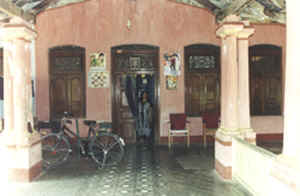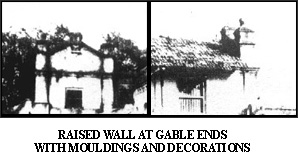 |
 |
|||||||||||||||||||||||||
|
In fact this subject deserve a separate study. Many houses built during British rule are still existing in all parts of Jaffna region. A very careful study is necessary to understand all aspects of these houses. I do not have much information for a study of this nature. This chapter will deal, only superficially, with a few types of changes made in the design of traditional court yard houses during this period.
When local officials, who were working for the colonial governments under Portuguese and Dutch, started building their houses to suit the newly found life-style, some changes may have been introduced in the traditional house types. The need to introduce European style loose furniture may have prompted the elimination of the the level changes inside the house. The level changes in the traditional houses were necessary to create "thinnai" and "nadai" combination, which functioned as built-in seats and the designated lowered walk ways to keep the sitting areas clean. This arrangement had become unnecessary with the introduction of loose furniture, and at the same time the floor space, fragmented with so many levels, was not convenient enough for the arrangement of furniture.
Another notable change had been the improvement of conditions related to the ventilation and lighting. Windows which were generally not found in traditional houses had been provided. The roof had been raised to create more space within the interior spaces. Front "thinnai" had been replaced by deep verandah which was a prominent element in the houses built for the Dutch residents of old Jaffna town.
The changes that took place in the domestic houses of local people of Jaffna during the 150 years under British rule were mostly cosmetic in nature. Including a few houses with an upper floor, which had been built by a few locals who had earned new wealth from Malaysia and Singapore, almost all houses considered as ideal, by the locals, had the concept of court yard unchanged. This trend had continued for less than a decade after the independence in 1948.
The factors that contributed for the decline of the demand for court yard houses and the introduction of a new type of houses are yet to be studied. A traditional system which had survived about 350 years of foreign rule had been almost immediately dropped by the locals once they achieve their independence seems very strange.
|
|||||||||||||||||||||||||
| Last updated on 04 February 2005 | ||||||||||||||||||||||||||
|
YOUR VISITOR NO. TO THIS SITE IS |
||||||||||||||||||||||||||


 There had been changes in the external appearance of the houses. Split
levels in roof, decorated walls raised above the roof at gable ends and raised front walls
with plaster decorations and motifs related to western concepts had become common in later
period houses.
There had been changes in the external appearance of the houses. Split
levels in roof, decorated walls raised above the roof at gable ends and raised front walls
with plaster decorations and motifs related to western concepts had become common in later
period houses.
 In the post independence period, even the
court yard houses of Vannarponnai had been renovated to suit the new attitudes and
life-style. "Thinnais" and "nadais" had been broken down to create one
level inside the house. The front "thinnais" which were open to the public
earlier had been closed with iron grills etc., and converted into a semi-private
verandah. Moreover usage of this area as a temporary resting place for passer-by had
vanished. The traffic started moving fast and the need for a short rest was no more a
consideration.
In the post independence period, even the
court yard houses of Vannarponnai had been renovated to suit the new attitudes and
life-style. "Thinnais" and "nadais" had been broken down to create one
level inside the house. The front "thinnais" which were open to the public
earlier had been closed with iron grills etc., and converted into a semi-private
verandah. Moreover usage of this area as a temporary resting place for passer-by had
vanished. The traffic started moving fast and the need for a short rest was no more a
consideration.